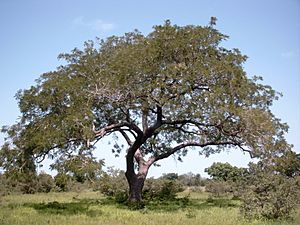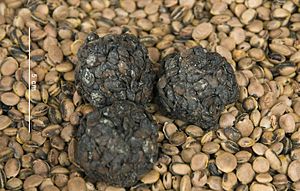Parkia biglobosa facts for kids
Quick facts for kids Parkia biglobosa |
|
|---|---|
 |
|
 |
|
| Inflorescences | |
| Conservation status | |
| Scientific classification | |
| Genus: |
Parkia
|
| Species: |
biglobosa
|
| Synonyms | |
|
List
|
|
The Parkia biglobosa, often called the African locust bean, is a special tree. It grows in many parts of Africa. People mainly grow it for its long pods. These pods hold a sweet pulp and valuable seeds. Turning these seeds into food is a big part of the local economy. Different parts of the tree are also used for medicine and food. This tree can even help other crops grow better nearby.
Contents
What the African Locust Bean Looks Like
The African locust bean tree is a type of plant that loses its leaves every year. It usually grows between 7 and 20 meters tall. Some trees can even reach up to 30 meters high. It has thick, dark gray-brown bark. This bark helps the tree resist fires.
The pods of the tree are often called locust beans. They start out pink and turn dark brown when they are ready. On average, the pods are 30-40 centimeters long. Some can be as long as 45 centimeters. Inside each pod, there can be up to 30 seeds. These seeds are surrounded by a sweet, yellow, powdery pulp.
Where the Tree Grows and Its History
In West Africa, people use the bark, roots, leaves, flowers, fruits, and seeds of this tree. They use them in traditional medicine for many different health issues. The bark is especially important for medicine. Leaves are also used a lot. People use them to help with things like infections, blood flow problems, and skin issues.
The African locust bean tree was first written about in 1757. But people in Africa have been using its fermented seeds since the 14th century.
You can find Parkia biglobosa across Africa. It grows from the Atlantic coast in Senegal all the way to southern Sudan. It is most common in areas where people farm regularly.
About 200,000 tons of seeds are produced each year in northern Nigeria. The products from this tree are not often sold internationally. However, they are very important for local trade in West Africa. The seeds are especially valuable. They are traded a lot between countries in the Sahel region.
How the African Locust Bean Grows
Starting Seeds
Each pod has two kinds of seeds: reddish-dark and dark (black). There are usually more dark seeds. Reddish-dark seeds have a thinner coat. They sprout faster than black seeds. Black seeds have a harder coat. They need special treatment to help them sprout well.
Normally, about 75% of the seeds will sprout. You can improve this by scalding the seeds for about 7 minutes. Then, soak them in hot water overnight before planting. Young locust bean trees can also be grown from cuttings. This means taking a piece of an adult tree and helping it grow roots.
Growing the Trees
After planting seeds, young plants can be moved into pots after 3 days. They usually grow to 20-25 centimeters tall in about 20 weeks. At this point, they are ready to be planted in a field. Planting seeds directly in the field is possible. But it depends on how moist the soil is and if insects or rodents are a problem. Preparing the soil first helps the young trees grow well.
Young trees grow quite fast. They can reach 1 meter tall in just one year. They start to flower when they are 5–7 years old. This happens during the dry season in the Sahel. Bats are the main pollinators for the tree. But bees, flies, and other insects also help. The trees start to produce fruit when they are 5–10 years old. The fruits ripen just before the first rains.
The leaves of the locust bean tree help make the soil healthier. In one study, the locust bean tree helped improve soil fertility. It also helped the soil gather more phosphorus and organic carbon.
Sometimes, the shade from the locust bean tree can affect other crops. In one experiment, the tree's shade reduced the growth of pearl millet. Eggplant yields were also much lower under the trees. However, chilli pepper yields actually increased by up to 150% under the locust bean tree.
Growing Conditions
The African locust bean tree needs certain conditions to grow well. It prefers altitudes between 0 and 300 meters. It needs an average rainfall of 400-700 millimeters per year. The average temperature should be around 24-28°C. It likes well-drained, thick clay soils. But it can also grow in shallow, sandy soils.
Uses of the African Locust Bean
Food Uses

The yellow pulp around the seeds is naturally sweet. People process it into a valuable food. The seeds are processed into a seasoning. This seasoning is called dawadawa by the Hausa people in Nigeria and Ghana. It is also known as sikomu by the Igbo people and irú by the Yoruba people. The sweet pulp is also used to make drinks.
The seeds are the most valuable part of the plant. They are rich in fats (29%), protein (35%), and carbohydrates (16%). They are a good source of fat and calcium for people in rural areas. First, the seeds are cooked to remove their outer coat. Then, they are fermented to make the seasoning. The fermented seeds can be pounded into a powder and formed into cakes.
Animal Feed
The fruit pulp, leaves, and seeds are also used to feed farm animals. This includes livestock and poultry. The flowers attract bees, making them a good source of nectar.
Economic Importance
Growing this tree is an important economic activity for many people in Africa. Many women are involved in this work. In Burkina Faso, néré fruits are widely sold. More than half of the people surveyed said they were part of this trade. Women are usually in charge of selling the fermented seeds (dawadawa). Both men and women sell the dry seeds.
Medical Uses
Traditional healers in Africa use different parts of the locust bean tree for health benefits. In a survey in Togo, Parkia biglobosa was one of the most common plants used to treat high blood pressure. In Nigeria, it was one of two plants known for helping wounds heal. It significantly helps skin cells grow.
In Guinea, Parkia biglobosa was listed among plants successfully used against malaria. Another study found that the plant has properties that fight bacteria. These properties are similar to those of strong medicines. This means the tree could be a source of new compounds to fight bacterial infections.


